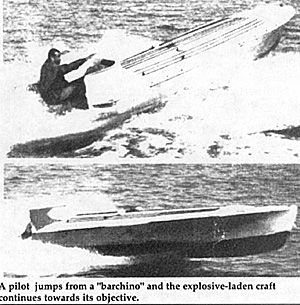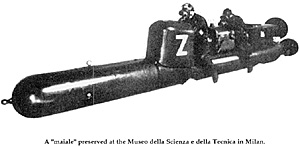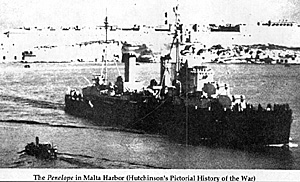Italy
 During the war, the Italians led the world in the innovative use
of their light assault craft. These forces, in conjunction with MAS
squadrons, were used with daring, skill, and an aggressiveness that
contrasted sharply to the use of Italy's major fleet units.
During the war, the Italians led the world in the innovative use
of their light assault craft. These forces, in conjunction with MAS
squadrons, were used with daring, skill, and an aggressiveness that
contrasted sharply to the use of Italy's major fleet units.
A pilot jumps from "Barchino" and the explosive-laden craft continues towards its objective.
They provided a series of dramatic victories and near misses that could well have thrown the Mediterranean to the Italians had they been exploited by an alert, aggressive general staff. As it was, they had little strategic impact.
The two main types of assault craft used in the raids were the barchini and the maiales (pigs). Some details on each:
- a. Barchinis were 16-foot flat-bottomed motorboats
with detachable prows filled with 300-kg explosive charges. These
boats had speeds of 32-34 knots and a full-speed radius of 60 miles. A
single pilot would aim the boat at the target, then eject onto a flotation
backrest upon which he could survive the coming explosion.
 b. Maiales were Italy's two man torpedoes. They were
nearly 7 meters in length, carrying a detachable charge of 300 kg. They
could move at a little over 2 knots within a radius of 15 miles and could
submerge to depths of 25-30 meters. The major drawback of these
weapons was their limited range. They had to be transported to the
vicinity of their targets area and this transportation step caused the
failure of many of the planned missions. But some got through.
b. Maiales were Italy's two man torpedoes. They were
nearly 7 meters in length, carrying a detachable charge of 300 kg. They
could move at a little over 2 knots within a radius of 15 miles and could
submerge to depths of 25-30 meters. The major drawback of these
weapons was their limited range. They had to be transported to the
vicinity of their targets area and this transportation step caused the
failure of many of the planned missions. But some got through.
On 26 March 1941, five barchinis penetrated Suda Bay, Crete, and gave the British Admiralty their first taste of how effective these craft could be. HMS York, the only 8" cruiser in the Mediterranean theater, was the primary target and had her stern blown off, forcing her to be beached. The Luftwaffe later destroyed her and claimed the credit, causing more hard feelings between the Axis Allies. A tanker and transport were also sunk in the raid, but accounts vary. In all, a very successful first for the Italians.
Four months later, Malta's Grand Harbor was the target, the primary objective being the submarines berthed there. Both barchini and maiales were used. Despite Malta's coastal radar stations, the attack force came close to penetrating the harbor. But the explosion that destroyed the harbor boom also collapsed a bridge into the path of the assault craft, cutting off their entrance to the harbor. Alerted, Malta's coastal batteries, aided by radar, and her air force destroyed the whole force. Although the attack had been unsuccessful and ended in annihilation of the attacking force, it had been a near thing.
In September, maiales tried to penetrate Gibraltar. Failing that, they attacked merchant shipping in the Roads, sinking several ships. Gibraltar would feel their bite later, from maiales based in a freighter at anchor in Spain.
On the night of 19-20 December 1941, a British destroyer came through the harbor defenses at Alexandria. In her unconscious wake came three maiales. The attack sank HMS Queen Elizabeth and HMS Valiant, and a tanker. Six men in one stroke had repaid the British for Taranto and shifted the balance of power back to the Italians by taking out the only two battleships Cunningham had left. The saving grace was that the Italian command took a long time to realize that the attack had been successful. Even when they did, they didn't take advantage of the new situation.
Great Britain
It has been stated before that Cunningham had not been satisfied with simply holding onto the beleaguered island of Malta - he wanted to use her for offensive operations against the Axis convoy routes to Libya. In spring 1941, with Italian fortunes at a low ebb, he took steps in that direction.
On 11 April, the first Malta Strike Force (MSF) was born, consisting of destroyers Jervis and Janus (six 4.7 guns, ten torpedo tubes) and destroyers Nubian and Mohawk (eight 4.7 guns and four tubes). Four days later, after two unsuccessful interception attempts, the MSF caught a convoy of five merchant ships and three escorting Italian destroyers.
In the ensuing melee, all three escorts were shot up by the MSF and the five merchants sunk, carrying some 15,000 tons of supplies to the bottom. HMS Mohawk was torpedoed during the engagement and sank, but the decision to base offensive ships had reaped its first rewards.
 The Strike Force was pulled out of Malta to aid in the slaughter
that was Crete. British losses were so severe, that it was October
before another force was sent to Malta. The island was enjoying a
respite in its siege because most of the aircraft pounding her had been
reassigned to Russia. Malta-based submarines and aircraft were
increasingly active against the Axis supply lines. To this, Cunningham
added Force K, composed of light cruisers Aurora and Penelope (at right) and
destroyers Lively and Lance.
The Strike Force was pulled out of Malta to aid in the slaughter
that was Crete. British losses were so severe, that it was October
before another force was sent to Malta. The island was enjoying a
respite in its siege because most of the aircraft pounding her had been
reassigned to Russia. Malta-based submarines and aircraft were
increasingly active against the Axis supply lines. To this, Cunningham
added Force K, composed of light cruisers Aurora and Penelope (at right) and
destroyers Lively and Lance.
Again it was only a matter of days before Force K justified its existence. The target was a large convoy of five cargo ships and two tankers, carrying nearly 40,000 tons of vital supplies under the close escort of six destroyers. Also trailing the convoy was an escort of two heavy cruisers and four destroyers. Force K, aided immeasurably by radar, attacked and sank all seven merchant ships and, in spite of active participation by the Italian heavy cruisers, escaped without a loss. It was an incredible display of skill, practice, and technology that had a severe impact on the Axis.
Ten days after this convoy was destroyed, while the Italians were devising other convoy methods, Operation Crusader was launched; and Rommel, starved for supply (in October/November 1942, 60-70% of his supply were sunk by Malta based forces), began his first westward retreat.
On 23 November, Force K sank two merchants escorted by the Lupo, the Italian escort of Crete fame. Again the little craft gave everything she had in defense of her charges, damaging the Penelope. But, as off Crete, she was only delaying the inevitable. The Force was becoming so successful that Cunningham reinforced them with light cruisers Ajax and Neptune and three destroyers.
On 9 December, the destroyers attacked and sank two Italian light cruisers, carrying 180 tons of barrelled fuel each on their decks. Once the fuel had been breached and set aflame, the two light cruisers never had a chance and both went down to torpedoes. Six days later, Force K took part in the First Battle of Sirte, escorting supplies into Malta.
On the night of 18-19 December, after two months of success, Force K, searching for an Italian convoy, ran into a newly laid minefield. Neptune was sunk, along with a destroyer that went to her aid, and Aurora and Penelope damaged. What air attack and surface attack had failed to do, the minefield accomplished in a single moment. Force K was virtually wiped out.
The destruction of Force K, combined with the daring success of the Italian maiale at Alexandria left the British in a very bad position. The deteriorating Far East situation kept them from reinforcing Cunningham, and German U-boats and Luftwaffe units were again making their presence felt in the Mediterranean. The balance of power had shifted again and with it the focal point of the Mediterranean struggle. As it was in early 1941, the conflict centered around the undisputed key to the region - Malta.
The Naval War in the Mediterranean 1940-1943
- Italians and British
The Opening Moves - 1940
Battle of Crete
Light Forces: Italians and British
Battles of Sirte
Malta Convoys
End Game
Italy's War Aims
State of the Regia Marina
Back to Table of Contents: CounterAttack # 2
To CounterAttack List of Issues
To MagWeb Master Magazine List
© Copyright 1988 by Pacific Rim Publishing Company.
This article appears in MagWeb (Magazine Web) on the Internet World Wide Web.
Other articles from military history and related magazines are available at http://www.magweb.com